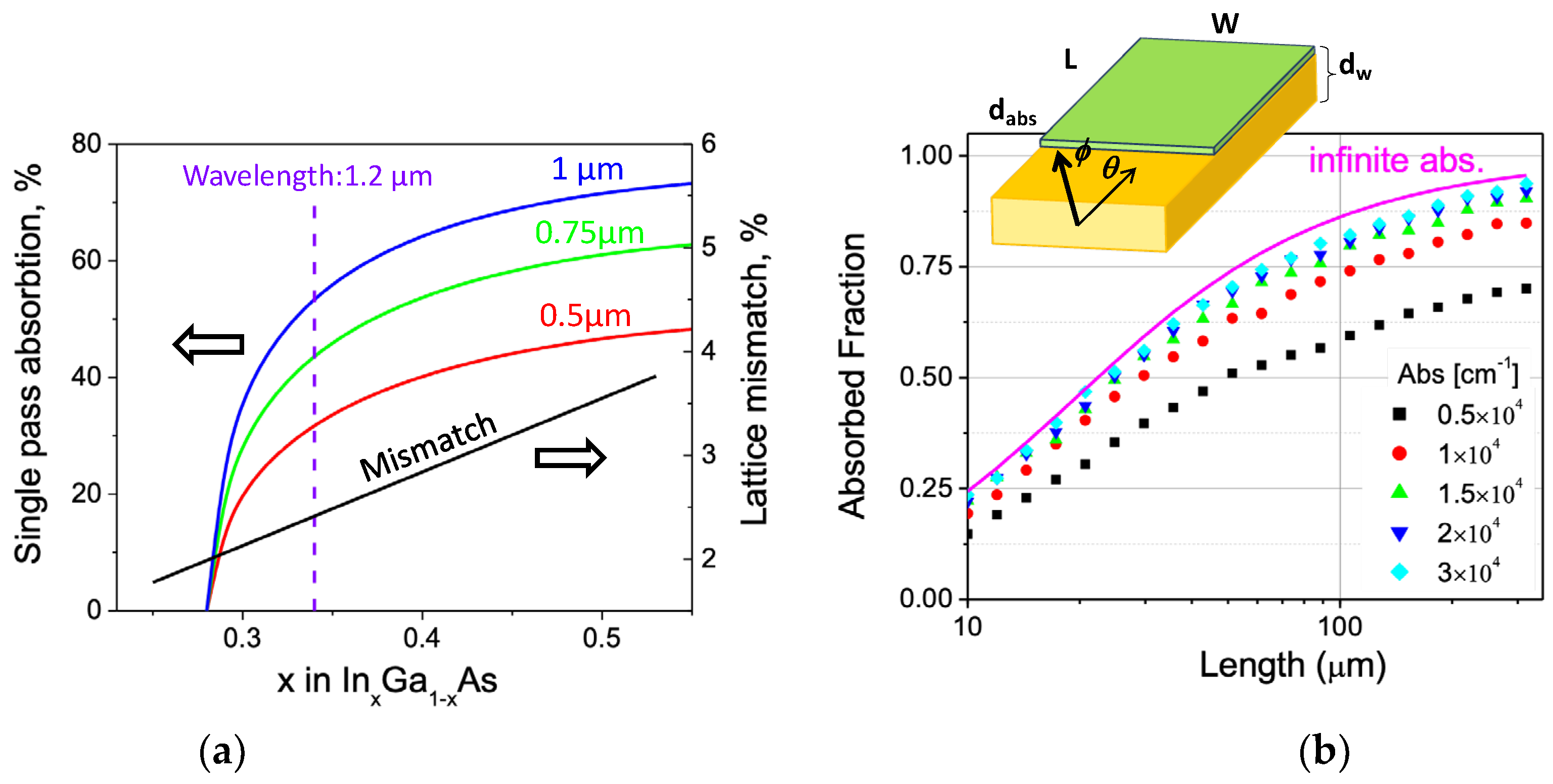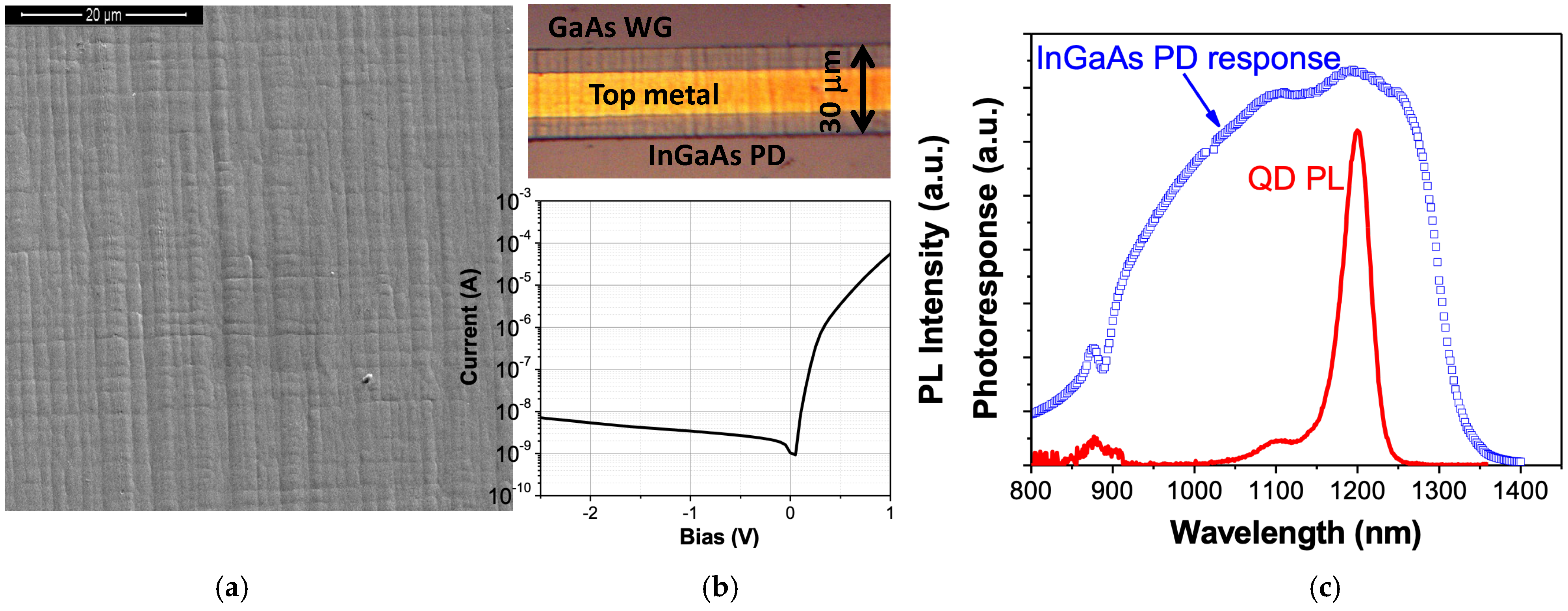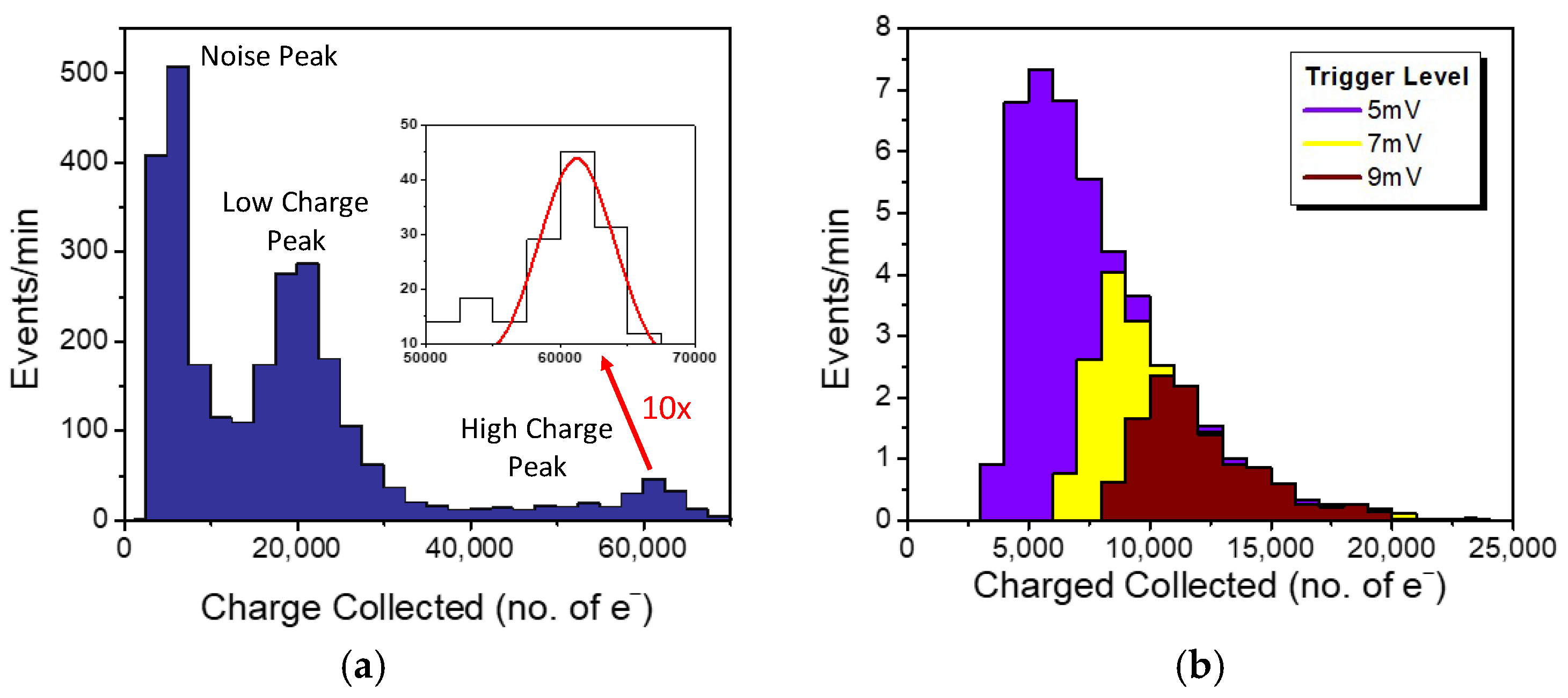Design and Performance of an InAs Quantum Dot Scintillator with Integrated Photodetector
Abstract
1. Introduction
2. Materials and Methods
3. Results and Discussion
3.1. Design of an Integrated Photodetector
3.2. Photoluminescence Collection Efficiency with an Integrated Photodetector
3.3. Detector Response to α-Particles and Photons
3.4. Radiation Hardness Measurements
4. Conclusions
Author Contributions
Funding
Institutional Review Board Statement
Informed Consent Statement
Data Availability Statement
Conflicts of Interest
References
- Lecoq, P. Development of New Scintillators for Medical Applications. Nucl. Instrum. Methods Phys. Res. Sect. A Accel. Spectrometers Detect. Assoc. Equip. 2016, 809, 130–139. [Google Scholar] [CrossRef]
- Wang, Z.; Guardincerri, E.; Rathman, D.D.; Azzouz, M.E.; Barnes, C.W.; Berger, R.; Bond, E.M.; Craig, D.M.; Holtkamp, D.; Kapustinsky, J.S.; et al. Gigahertz (GHz) Hard X-Ray Imaging Using Fast Scintillators. Proc. SPIE 2013, 8852, 88521A1-13. [Google Scholar] [CrossRef]
- Glodo, J.; Wang, Y.; Shawgo, R.; Brecher, C.; Hawrami, R.H.; Tower, J.; Shah, K.S. New Developments in Scintillators for Security Applications. Phys. Procedia 2017, 90, 285–290. [Google Scholar] [CrossRef]
- Derenzo, S.E.; Bourret-Courshesne, E.; Bizarri, G.; Canning, A. Bright and Ultra-Fast Scintillation from a Semiconductor? Nucl. Instrum. Methods Phys. Res. Sect. A Accel. Spectrometers Detect. Assoc. Equip. 2016, 805, 36–40. [Google Scholar] [CrossRef]
- Zhao, L.; Hu, L.; Fang, X. Growth and Device Application of CdSe Nanostructures. Adv. Funct. Mater. 2012, 22, 1551–1566. [Google Scholar] [CrossRef]
- Zhang, Q.; Li, H.; Ma, Y.; Zhai, T. ZnSe Nanostructures: Synthesis, Properties and Applications. Prog. Mater. Sci. 2016, 83, 472–535. [Google Scholar] [CrossRef]
- Lee, G.-J.; Wu, J.J. Recent Developments in ZnS Photocatalysts from Synthesis to Photocatalytic Applications—A Review. Powder Technol. 2017, 318, 8–22. [Google Scholar] [CrossRef]
- Popescu, D.P.; Eliseev, P.G.; Stintz, A.; Malloy, K.J. Carrier Migration in Structures with InAs Quantum Dots. J. Appl. Phys. 2003, 94, 2454–2458. [Google Scholar] [CrossRef]
- Luryi, S.; Subashiev, A. Semiconductor Scintillator for Three-Dimensional Array of Radiation Detectors. In Future Trends in Microelectronics; Luryi, S., Xu, J., Zaslavsky, A., Eds.; Wiley: Hoboken, NJ, USA, 2010; pp. 331–346. ISBN 978-0-470-55137-0. [Google Scholar]
- Knoll, G.F. Radiation Detection and Measurement, 4th ed.; Wiley: Hoboken, NJ, USA, 2010. [Google Scholar]
- Available online: https://scintillator.lbl.gov/inorganic-scintillator-library/ (accessed on 11 June 2024).
- Luryi, S. Impregnated Semiconductor Scintillator. Int. J. High Speed Electron. Syst. 2008, 18, 973–982. [Google Scholar] [CrossRef]
- Oktyabrsky, S.; Yakimov, M.; Tokranov, V.; Murat, P. Integrated Semiconductor Quantum Dot Scintillation Detector: Ultimate Limit for Speed and Light Yield. IEEE Trans. Nucl. Sci. 2016, 63, 656–663. [Google Scholar] [CrossRef]
- Dropiewski, K.; Minns, A.; Yakimov, M.; Tokranov, V.; Murat, P.; Oktyabrsky, S. Ultrafast Waveguiding Quantum Dot Scintillation Detector. Nucl. Instrum. Methods Phys. Res. Sect. A Accel. Spectrometers Detect. Assoc. Equip. 2020, 954, 161472. [Google Scholar] [CrossRef]
- Dropiewski, K.; Minns, A.; Yakimov, M.; Tokranov, V.; Murat, P.; Oktyabrsky, S. Optical Properties of InAs Quantum Dots/GaAs Waveguides for Ultra-Fast Scintillators. J. Lumin. 2020, 220, 116952. [Google Scholar] [CrossRef]
- Minns, A.; Dropiewski, K.; Yakimov, M.; Tokranov, V.; Hedges, M.; Murat, P.; Oktyabrsky, S. Parameters of Fast and High-Yield InAs/GaAs Quantum Dot Semiconductor Scintillator. MRS Adv. 2021, 6, 297–302. [Google Scholar] [CrossRef]
- Joyce, W.B.; Bachrach, R.Z.; Dixon, R.W.; Sealer, D.A. Geometrical Properties of Random Particles and the Extraction of Photons from Electroluminescent Diodes. J. Appl. Phys. 1974, 45, 2229–2253. [Google Scholar] [CrossRef]
- Zhmakin, A.I. Enhancement of Light Extraction from Light Emitting Diodes. Phys. Rep. 2011, 498, 189–241. [Google Scholar] [CrossRef]
- Yablonovitch, E.; Gmitter, T.; Harbison, J.P.; Bhat, R. Extreme Selectivity in the Lift-off of Epitaxial GaAs Films. Appl. Phys. Lett. 1987, 51, 2222–2224. [Google Scholar] [CrossRef]
- Tokranov, V.E.; Yakimov, M.; Katsnelson, A.; Lamberti, M.; Oktyabrsky, S. Shape Engineered InAs Quantum Dots with Stabilized Electronic Properties. Proc. SPIE 2003, 4999, 79–88. [Google Scholar] [CrossRef]
- Varghese, A.; Yakimov, M.; Tokranov, V.; Mitin, V.; Sablon, K.; Sergeev, A.; Oktyabrsky, S. Complete Voltage Recovery in Quantum Dot Solar Cells Due to Suppression of Electron Capture. Nanoscale 2016, 8, 7248–7256. [Google Scholar] [CrossRef]
- Kasamatsu, N.; Kada, T.; Hasegawa, A.; Harada, Y.; Kita, T. Effect of Internal Electric Field on InAs/GaAs Quantum Dot Solar Cells. J. Appl. Phys. 2014, 115, 083510. [Google Scholar] [CrossRef]
- Lubyshev, D.; Liu, W.K.; Stewart, T.R.; Cornfeld, A.B.; Fang, X.M.; Xu, X.; Specht, P.; Kisielowski, C.; Naidenkova, M.; Goorsky, M.S.; et al. Strain Relaxation and Dislocation Filtering in Metamorphic High Electron Mobility Transistor Structures Grown on GaAs Substrates. J. Vac. Sci. Technol. B Microelectron. Nanometer Struct. Process. Meas. Phenom. 2001, 19, 1510–1514. [Google Scholar] [CrossRef]
- Minns, A.; Mahajan, T.; Tokranov, V.; Yakimov, M.; Hedges, M.; Murat, P.; Oktyabrsky, S. Device Response Principles and the Impact on Energy Resolution of Epitaxial Quantum Dot Scintillators with Monolithic Photodetector Integration. Sci. Rep. 2024, 14, 22870. [Google Scholar] [CrossRef] [PubMed]
- Romanato, F.; Napolitani, E.; Carnera, A.; Drigo, A.V.; Lazzarini, L.; Salviati, G.; Ferrari, C.; Bosacchi, A.; Franchi, S. Strain Relaxation in Graded Composition InxGa1−xAs/GaAs Buffer Layers. J. Appl. Phys. 1999, 86, 4748–4755. [Google Scholar] [CrossRef]
- Jang, J.-H.; Cueva, G.; Hoke, W.E.; Lemonias, P.J.; Fay, P.; Adesida, I. Metamorphic Graded Bandgap InGaAs-InGaAlAs-InAlAs Double Heterojunction p-i-I-n Photodiodes. J. Light. Technol. 2002, 20, 507–514. [Google Scholar] [CrossRef]
- Hoke, W.E.; Lemonias, P.J.; Kennedy, T.D.; Torabi, A.; Tong, E.K.; Bourque, R.J.; Jang, J.-H.; Cueva, G.; Dumka, D.C.; Adesida, I.; et al. Metamorphic Heterojunction Bipolar Transistors and P–I–N Photodiodes on GaAs Substrates Prepared by Molecular Beam Epitaxy. J. Vac. Sci. Technol. B Microelectron. Nanometer Struct. Process. Meas. Phenom. 2001, 19, 1505–1509. [Google Scholar] [CrossRef]
- Birks, J.B. Scintillations from Organic Crystals: Specific Fluorescence and Relative Response to Different Radiations. Proc. Phys. Soc. A 1951, 64, 874–877. [Google Scholar] [CrossRef]
- Berger, M.; Hubbell, J.; Seltzer, S.; Coursey, J.; Zucker, D. XCOM: Photon Cross Section Database (Version 1.2). XCOM: Photon Cross Section Database (Version 1.2). 1999. Available online: http://physics.nist.gov/xcom (accessed on 11 June 2024).
- Agostinelli, S.; Allison, J.; Amako, K.; Apostolakis, J.; Araujo, H.; Arce, P.; Asai, M.; Axen, D.; Banerjee, S.; Barrand, G.; et al. Geant4—A Simulation Toolkit. Nucl. Instrum. Methods Phys. Res. Sect. A Accel. Spectrometers Detect. Assoc. Equip. 2003, 506, 250–303. [Google Scholar] [CrossRef]
- Oktyabrsky, S.; Lamberti, M.; Tokranov, V.; Agnello, G.; Yakimov, M. Room-Temperature Defect Tolerance of Band-Engineered InAs Quantum Dot Heterostructures. J. Appl. Phys. 2005, 98, 053512. [Google Scholar] [CrossRef]
- Summers, G.P.; Burke, E.A.; Xapsos, M.A.; Dale, C.J.; Marshall, P.W.; Petersen, E.L. Displacement Damage in GaAs Structures. IEEE Trans. Nucl. Sci. 1988, 35, 1221–1226. [Google Scholar] [CrossRef]
- Akkerman, A.; Barak, J.; Chadwick, M.B.; Levinson, J.; Murat, M.; Lifshitz, Y. Updated NIEL Calculations for Estimating the Damage Induced by Particles and γ-Rays in Si and GaAs. Radiat. Phys. Chem. 2001, 62, 301–310. [Google Scholar] [CrossRef]
- Yang, F.; Zhang, L.; Zhu, R.-Y.; Kapustinsky, J.; Nelson, R.; Wang, Z. Proton Induced Radiation Damage in Fast Crystal Scintillators. Nucl. Instrum. Methods Phys. Res. Sect. A Accel. Spectrometers Detect. Assoc. Equip. 2016, 824, 726–728. [Google Scholar] [CrossRef]
- Hara, K.; Allport, P.P.; Baca, M.; Broughton, J.; Chisholm, A.; Nikolopoulos, K.; Pyatt, S.; Thomas, J.P.; Wilson, J.A.; Kierstead, J.; et al. Charge Collection and Field Profile Studies of Heavily Irradiated Strip Sensors for the ATLAS Inner Tracker Upgrade. Nucl. Instrum. Methods Phys. Res. Sect. A Accel. Spectrometers Detect. Assoc. Equip. 2016, 831, 181–188. [Google Scholar] [CrossRef]








Disclaimer/Publisher’s Note: The statements, opinions and data contained in all publications are solely those of the individual author(s) and contributor(s) and not of MDPI and/or the editor(s). MDPI and/or the editor(s) disclaim responsibility for any injury to people or property resulting from any ideas, methods, instructions or products referred to in the content. |
© 2024 by the authors. Licensee MDPI, Basel, Switzerland. This article is an open access article distributed under the terms and conditions of the Creative Commons Attribution (CC BY) license (https://creativecommons.org/licenses/by/4.0/).
Share and Cite
Mahajan, T.; Minns, A.; Tokranov, V.; Yakimov, M.; Hedges, M.; Murat, P.; Oktyabrsky, S. Design and Performance of an InAs Quantum Dot Scintillator with Integrated Photodetector. Sensors 2024, 24, 7178. https://doi.org/10.3390/s24227178
Mahajan T, Minns A, Tokranov V, Yakimov M, Hedges M, Murat P, Oktyabrsky S. Design and Performance of an InAs Quantum Dot Scintillator with Integrated Photodetector. Sensors. 2024; 24(22):7178. https://doi.org/10.3390/s24227178
Chicago/Turabian StyleMahajan, Tushar, Allan Minns, Vadim Tokranov, Michael Yakimov, Michael Hedges, Pavel Murat, and Serge Oktyabrsky. 2024. "Design and Performance of an InAs Quantum Dot Scintillator with Integrated Photodetector" Sensors 24, no. 22: 7178. https://doi.org/10.3390/s24227178
APA StyleMahajan, T., Minns, A., Tokranov, V., Yakimov, M., Hedges, M., Murat, P., & Oktyabrsky, S. (2024). Design and Performance of an InAs Quantum Dot Scintillator with Integrated Photodetector. Sensors, 24(22), 7178. https://doi.org/10.3390/s24227178





